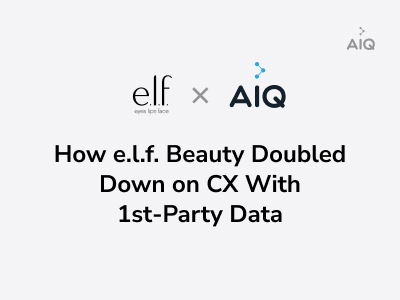How to identify gifter segments for targeted retail holiday campaigns
August 23, 2021The winter holidays are traditionally the most significant promotional period of the year, averaging about 19% of annual retail sales over the past five years.
That uptick in sales during the holiday season doesn’t happen without effort, however. For most brands and retailers, successful holiday marketing requires months of focused customer research, strategic planning, and campaign setup.
Customer data platforms (CDPs) can help you plan and manage your holiday campaigns with ease. If you start now, you can easily identify high-value audiences and personalize your holiday marketing to maximize your returns.
In this blog, we’ll walk you through four data-driven strategies to identify the right audiences for one of the most common types of holiday campaigns: Gifting campaigns.
How to identify gifter segments for targeted retail holiday campaigns
1. Self-segmentation via customer surveys.
The easiest way to learn more about who your customers are and what motivates them to purchase? Just ask.
Using customer surveys, you can directly ask customers who they’re shopping for and what their preferences are. This information, given freely with the knowledge that it’ll be used to improve the customer experience, is known as zero-party data.
CDPs with built-in form builder features can help you easily set up custom surveys suited for your goals and automatically unify form responses to individual customer profiles. That way, identifying gifter audiences is as simple as segmenting your database into customers who self-selected as gifters in your survey.
2. Segmentation by last year’s gift card purchases.
Gift cards are a very obvious signal that customers are buying for someone other than themselves.
Using your product data, sort your database by customers who purchased gift cards during the previous holiday season. This segment will be perfect for gift-related messaging, although you may want to dig a little deeper into your data to see if there are additional layers of insights and personalization you can bring to your campaign.
For example, you could segment gift card buyers by gender, lifetime value, or location to create additional opportunities for contextualized messaging.
Promoting digital gift cards can also reduce the strain on your fulfillment team and any delivery services you use. This strategy can help mitigate the kind of significant shipping delays experienced during the 2020 holiday season and improve overall customer satisfaction.
3. Inferred segmentation based on past purchases.
Identifying gifters in your database isn’t always as obvious as collecting survey data or segmenting by gift card purchases. Sometimes, you need to consider multiple data points at the same time to infer buyer motivations.
If you look at both gender and the product categories of past purchases, you might be able to identify clear signs of gifting among your customers, such as men who buy women’s products or women who buy children’s products. Once you identify these gifters, you can target them with personalized marketing campaigns with gift-related messaging such as “for him” or “for her” gift guides.
For example, Mountain Khakis analyzed newly acquired customers from a holiday campaign and found that a large number of new female customers had purchased men’s products. By retargeting these customers with messaging related to their gifting motivation, Mountain Khakis was able to drive a second purchase 2 to 3 weeks after the first purchase, resulting in a 7.1x ROAS.
4. Segmentation by the frequency and recency of purchases.
Finally, you can identify customers with gifting motivations by segmenting your database by the frequency and recency of purchases.
This approach is part of RFM (recency, frequency, monetary) segmentation, which is a proven method for improving personalization and increasing returns. Understanding how recently customers have purchased, how often they purchase from you, and how much they spend can help you deliver more targeted marketing at the right moments and with the right cadence.
Customers who purchased during last year’s holiday sale but haven’t purchased from your brand since may make effective audiences for holiday-related messaging.
Looking for more retail holiday campaign tips?
This article was adapted from Lexer’s guide, “Retail Holiday Marketing: 9 Campaigns You Need to Plan Now.” If you liked this, you’ll probably find more value in the original, in-depth version too, which includes ideas and processes for 9 top-performing holiday campaigns. Click here to download the full version of the 2021 retail holiday guide.
Lexer is the Customer Data & Experience Platform of choice for leading brands like Quiksilver, Igloo, Supergoop!, and more. As the only CDP built specifically for retail, we help brands and retailers drive incremental sales growth through improved customer experiences.


